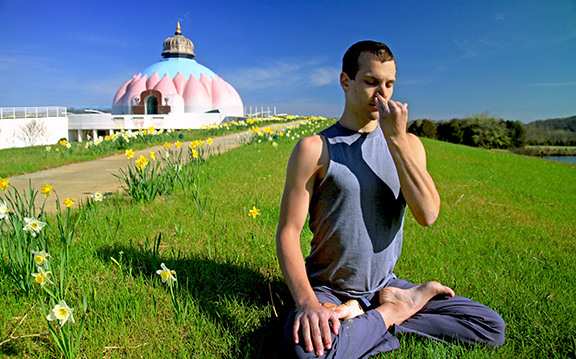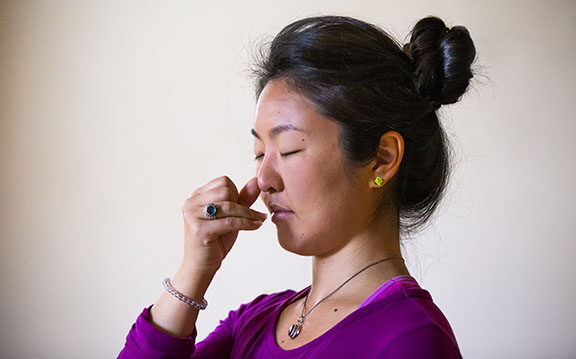 Pranayama, often described as yogic breathing, is one of the most powerful, yet subtle practices in Yoga. Certainly, we use yogic breathing techniques to practice pranayama—but if we mistake these techniques for the intent, we cut ourselves off from the full scope of what the teachings are designed to give us. We use the breath, but we must move beyond the breath to discover the more profound purpose of pranayama.
Pranayama, often described as yogic breathing, is one of the most powerful, yet subtle practices in Yoga. Certainly, we use yogic breathing techniques to practice pranayama—but if we mistake these techniques for the intent, we cut ourselves off from the full scope of what the teachings are designed to give us. We use the breath, but we must move beyond the breath to discover the more profound purpose of pranayama.
Sri Swami Sivananda says: “Pranayama or the control of prana, is that means by which the yogi tries to realize in this little body the whole of cosmic life and tries to attain perfection by getting all the powers in this universe. His various exercises and trainings are for this one end.”
In the manifest world, there are two aspects to everything: prana and akasha. Akasha is the substance of being, and prana is the energy or life force. Pranayama is most accurately described as the restraint, or management of that vital energy. We readily note prana in the blowing of the wind, in the light and heat of the sun and in spectacular displays of lighting. We have come to recognize this vital energy in the forces of gravity and magnetism and in the tremendous power that is contained within each atom.
When asked, “Are you breathing now?” most people reply, “Yes.” Yet, we are really being breathed. In other words, we are usually not actively, consciously participating in the breathing process. More often than not, the universe simply breathes our bodies— with no attention at all, the breath flows in and out. This is yet another manifestation of prana. We may more easily become aware of this during Yoga Nidra, when we have consciously surrendered control of the breath. Sri Swami Satchidananda (Sri Gurudev) would often point this out by reminding us to give thanks to God for the breath going in and out of these bodies, he noted that, as long as God is breathing our bodies, there is still something for us to be doing in this lifetime. He would tell us to just try and stop breathing. If we are very good at holding the breath, we might eventually pass out, and then the universe will again take over and begin to breathe our bodies for us.
While it is difficult for us to manipulate gravity, or the sun, or lightning, or the wind, we are able to quite easily manage the flow of breath through the body. We can slow it down or speed it up, make it shallow or deep. We can pause it, play with it and shape the pattern in myriad ways. Because we can so easily take hold of the breath and begin to direct it willfully, the breathing practices give us a handle on the life force itself. So here is the way for us to manage the prana—pranayama. Note, however, that the breath is not itself the prana; it is merely the handle by which we can manage the prana.
The breathing practices of pranayama are wonderful. Each has its own special benefits and effects upon our energy and mental planes, as well as the ability to help on the physical level. It is common, especially when first beginning to work with prana, to put our focus on the physical level—using the breath to purify the nerves or the blood. While these are good benefits to be sure, if our focus remains on the physical, we miss the fuller potential that is available to us when we expand our focus to the energetic field. The danger lies in becoming too interested and involved in the benefits of the breathing practices that we lose touch with the principal purpose, which is to manage the prana.
Sri Patanjali, listing pranayama as one of the eight limbs of Raja Yoga, tells us that, by managing the inhalations and exhalations, the veil over the inner light will be removed. I often tell my students that, if all I taught them was to truly fall in love with the deep breathing, so that they practiced regularly and with full attention, I would be satisfied as a Yoga instructor. So much takes place when we attend to and consciously direct the breath: Awareness is drawn inward and the mind becomes focused rather than scattered. In this focused state, the mind is much more powerful and its impact can be felt wherever we direct our attention. If you’ve been frustrated with efforts you’ve made to bring about change in your life, try this. Things begin to happen. This is pranayama.
Because the seemingly simple breathing practices of pranayama truly enable us to work with the life force itself, it is important to proceed with some care. If we consider only the air that is moving in and out of the body, there is little cause for concern. When working with the unlimited source of power that is prana, however, prudence is advised. When done without proper preparation and guidance, the pranayama practices can result in physical pain, emotional anxiety and other difficulties. Furthermore, we should be extra attentive when adding kumbhaka, or retention of the breath, to our practice as it functions like an amplifier. Build up slowly, remembering to keep the entire practice comfortable. Sri Gurudev taught us to practice in a very patient and gentle fashion, focusing on removing the veil and realizing our true Self—and not on reaching for powers and abilities (siddhis). When we practice with this intent, we avoid getting sidetracked onto these more risky avenues.
Once we are aware of the prana itself, whole new realms of possibility blossom open. We can build up a good supply and use it to resolve physical, emotional and circumstantial life issues for ourselves and others. To do this you need a focused mind, clear intent, a full charge of pranic energy and a heartfelt connection with the other person. The same is true when doing pranic healing for yourself. The basic pranayama practices that we use in our Integral Yoga classes, deergha swaasam (deep yogic breathing), kapalabhati (the “skull shining breath” or rapid diaphragmatic breathing series) and nadi suddhi (the nerve purification or alternate nostril breathing) provide tremendous benefits resulting in a full supply of prana, clearing of toxins, stimulation of all of the endocrine glands, development of a clear mind and opening of the channels so that each of the chakras (energy centers) will function in full capacity.
Sometimes people feel that they should skip the yogic breathing practices when the air quality is questionable, but that is not necessary. We certainly notice and benefit when the atmosphere is clear and charged with positive spiritual energies, and of course, it is easier to stay focused and enjoy the practice when we find the air, the temperature and the environment clean, comfortable and pleasant. Our body systems, however, have a wonderful capacity to serve as pranic generators. Most of the prana is actually generated by our management of the flow of breath, rather than from the air.
Here are some things to try when practicing pranayama: Once you have established a basic breathing pattern, shift your attention from the breath itself to observe what is happening energetically. Don’t worry about doing it as well as you imagine someone else might do it, or about trying to keep up with someone else’s pattern. Avoiding such comparisons is one of the reasons that Master Sivananda encourages us to do pranayama by ourselves. When we practice alone, we can more easily find what is most comfortable for us. Interestingly, when we approach our practice very comfortably, the breathing pattern naturally slows down and deepens. Our attention moves inward and the practice becomes a real delight, allowing us to spend more time with it safely.
 A wonderful, subtle pranayama practice that can bring you into very clear contact with the pranic flow is doing nadi suddhi without using the hand in Vishnu mudra to seal the nostrils in an alternating pattern. Instead, keep your principle focus on moving the prana through the two channels—ida, associated with the left nostril, and pingala, associated with the right nostril. In this practice, though you should try to emphasize or accent the flow of air in the nostril upon which you’re focusing, don’t be concerned if there’s air moving through both nostrils. Be careful not to scrunch the face up in an effort to close off one nostril or the other. People tend to do this when their attention is on the flow of air, but the focus should be kept on the energy itself.
A wonderful, subtle pranayama practice that can bring you into very clear contact with the pranic flow is doing nadi suddhi without using the hand in Vishnu mudra to seal the nostrils in an alternating pattern. Instead, keep your principle focus on moving the prana through the two channels—ida, associated with the left nostril, and pingala, associated with the right nostril. In this practice, though you should try to emphasize or accent the flow of air in the nostril upon which you’re focusing, don’t be concerned if there’s air moving through both nostrils. Be careful not to scrunch the face up in an effort to close off one nostril or the other. People tend to do this when their attention is on the flow of air, but the focus should be kept on the energy itself.
So give this a try: Exhale through both nostrils and bring the attention now to the left nostril—the ida channel—and inhale, gently, subtly, feeling the energy flow in through the left nostril. Now shift the attention to the right nostril and direct the air—but mostly the energy—to flow out through the right nostril and side, pingala. Bring it in through the right side now, and then move the attention to the left nostril and, again, direct the air and energy to flow out through the left side. Continue with this. You will find that your attention is drawn deep within and that your awareness clearly recognizes the energy layer of your being. As you observe the energy moving through the nadis, ida and pingala, eventually, you’ll note that they become clear and balanced and then you’ll become familiar with the energy flowing more richly through the central channel, sushumna. Live in fullness. Enjoy.
 About the Author:
About the Author:
Jayadeva Mandelkorn began teaching Yoga in 1969 and was blessed with the opportunity to have studied and lived with Sri Swami Satchidananda, the founder of Integral Yoga, at Satchidananda Ashram-Yogaville. Jayadeva went on to serve as the manager of the Integral Yoga Institute in New York City and its director of Integral Yoga Teacher Training. He brought Integral Yoga to the Princeton, New Jersey area 20 years ago and serves as the director of Integral Yoga Princeton/Princeton Yoga Community Center.

